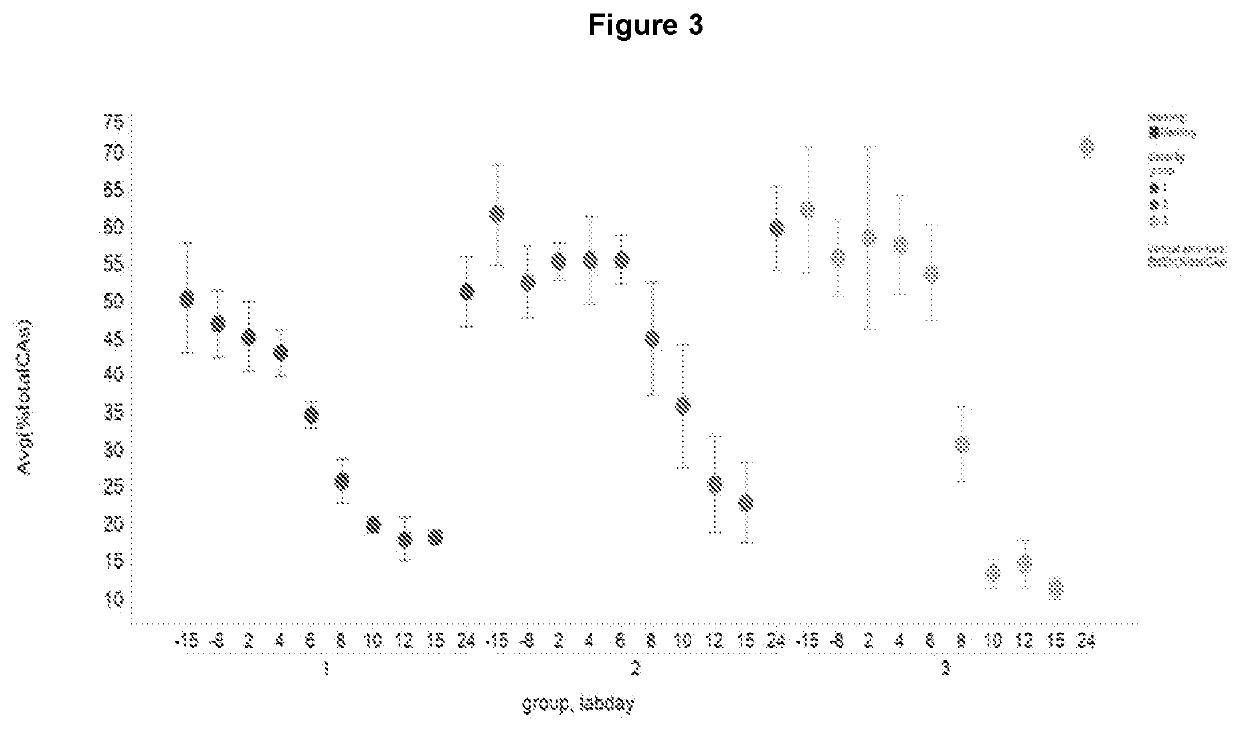Combination treatment of liver diseases using fxr agonists
a technology of farnesoid x receptor and liver disease, which is applied in the direction of heterocyclic compound active ingredients, organic active ingredients, drug compositions, etc., can solve the problems of no approved nash therapy, liver disease progression limitation or reverse, and cardiac mortality is an important cause of death in nash patients, etc. , to achieve the effect of improving ldl cholesterol, high therapeutic efficacy, and low incidence of side effects
- Summary
- Abstract
- Description
- Claims
- Application Information
AI Technical Summary
Benefits of technology
Problems solved by technology
Method used
Image
Examples
embodiments (
b)
[0072]1 b. A method for the treatment of a condition mediated by Farnesoid X receptor (FXR), in particular a liver disease or an intestinal disease, in a subject in need thereof, comprising administering to said subject a pharmaceutical combination comprising:[0073](i) an FXR agonist, wherein the FXR agonist is administered once daily at a therapeutically effective dose, and wherein the FXR agonist is administered in the evening, and[0074](ii) an SGLT inhibitor, e.g. SGLT 1 / 2 inhibitor.
[0075]2b. A method for the prevention of a condition mediated by Farnesoid X receptor (FXR), in particular a liver disease or an intestinal disease, in a subject in need thereof, comprising administering to said subject a pharmaceutical combination comprising:[0076](i) an FXR agonist, wherein the FXR agonist is administered once daily at a therapeutically effective dose, and wherein the FXR agonist is administered in the evening, and[0077](ii) an SGLT inhibitor, e.g. SGLT 1 / 2 inhibitor.
[0078]3b. A m...
example 1
A 2 Week Study in Cynomolgus Monkey Treated with an FXR Agonist
[0204]The rate of total bile acid production and the major subsets of the different bile acids have been measured in a 2 week study in Cynomolgus monkey treated with an FXR agonist (LJP305), as shown in FIG. 1 and described in Table 1.
TABLE 1Study design.No. ofDoseDoseAnimalsLevelConcentrationGroupMale(mg / kg / day)(mg / mL)Phase I1 LJP305-NX-11 (Low)40.10.022 LJP305-NX-11 (Mid)410.23 LJP305-NX-11 (High)430.6
[0205]Although total bile acids were decreased (FIG. 2), the ratio of CA to CDCA bile acid was altered overtime with a severe decrease in CA (FIG. 3) but a concomitant increase in CDCA bile acids (FIG. 4).
[0206]The most effective method to avoid such an inhibition of Cyp7A1 and consequent activation of the alternate pathway would be to administer an FXR agonist when the enzymatic activity of Cyp7A1 is at the lowest in order to minimize the effect of an FXR-mediated inhibition of the Cyp1A1. As the activity of this enzyme ...
example 2
In Vitro Human Hepatocytes Treated with FXR Agonists
[0207]FXR agonist treatments have been associated, in human, with lipid abnormalities, including increases in peripheral LDL. Increased cholesterol in hepatocytes is associated with a counter mechanism of decrease LDL receptor on the surface of the cells. Such a decrease in the LDL receptor on the surface of the hepatocytes will ultimately results in increases in circulating LDL; the phenotype observed in the clinics.
[0208]FIG. 5 shows that in vitro, using in vitro human hepatocytes, the FXR agonists, such as obeticholic acid (OCA) and cilofexor (GS-9674), reduce the LDL uptake by hepatocytes in a dose dependent manner. Those data indicates that blocking of the Cyp7A1 and the bile acid pathway leads to the peripheral increase in LDL. To mitigate the increase in peripheric LDL, we hypothesize that treating the subjects in the evening (from about 6 pm to about 12 pm, e.g. from about 8 pm to about 11 pm, preferably around 9 pm) would ...
PUM
| Property | Measurement | Unit |
|---|---|---|
| weight loss | aaaaa | aaaaa |
| time | aaaaa | aaaaa |
| time | aaaaa | aaaaa |
Abstract
Description
Claims
Application Information
 Login to View More
Login to View More - R&D
- Intellectual Property
- Life Sciences
- Materials
- Tech Scout
- Unparalleled Data Quality
- Higher Quality Content
- 60% Fewer Hallucinations
Browse by: Latest US Patents, China's latest patents, Technical Efficacy Thesaurus, Application Domain, Technology Topic, Popular Technical Reports.
© 2025 PatSnap. All rights reserved.Legal|Privacy policy|Modern Slavery Act Transparency Statement|Sitemap|About US| Contact US: help@patsnap.com



